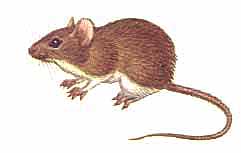Pests
Apodemus (Sylvaemus) sylvaticus Linnaeus (1758) - Long-Tailed Field Mouse.
Systematic position.
Class Mammalia, order Rodentia, family Muridae, genus Apodemus, subgenus Sylvaemus. All species of the genus Apodemus are characterized by high individual and geographical variability, so specific composition of the genus and intraspecific composition of Apodemus (Sylvaemus) sylvaticus is unclear and weakly developed. There is no single point of view on the taxonomy of this species up to now. Meanwhile, Apodemus sylvaticus is regarded as a typical species of the subgenus Sylvaemus.Biological group.
Rodent pests.Morphology and biology.
Body length is usually up to 100 mm, reaching 105 mm in the largest individuals. Tail is long, but always shorter than body, equal to 92% of body length on average. Ears are big, protruding from the fur. Eyes are large. Hind sole is long, 18-21.5 mm, rarely 22.0-22.5 mm. There is a characteristic yellow spot on the chest that is sometimes absent in young, unmolted mice. The coloration of the upper part contrasts with that of underparts of the body. Tail is strongly bicolored. Diploid chromosome set is 2n=48. This animal prefers broad-leaved and mixed forests, avoiding dry stipa steppes. A. sylvaticus is adapted to dwelling in diverse biotopes, including agrocenoses, where it colonizes grain crops and perennial grasses, protective forest belts, shrub thickets, gullies, and uncultivable lands.Distribution.
Western, Central and Southern Europe, British Isles, southern part of Scandinavian Peninsula. Within the Former Soviet Union, it occurs in almost all Ukraine (except the eastern part, Crimea, and Kherson Region), in Byelorussia (Brest, Grodno, Gomel, and Minsk Regions), Lithuania (along the border with Poland), Kaliningrad and Bryansk Regions. Distribution area of this species expands as forest clearings disappear and agrocenoses are formed in the place of forests.Ecology.
This animal is active at night. It is not aggressive, having a solitary lifestyle. A. sylvaticus runs well and escapes a chase with long jumps. It climbs shrubs and trees well. Its diet consists mainly of seeds. Also, animal food is regularly present in diet, and there is a small amount of green parts of plants there. The instinctual nature of making food stores manifests itself strongly. In winter, the food stores allow this animal to live under the soil surface for a long time. Burrows have a simple construction, and in places with compressed soil, this animal uses burrows of other rodent species, as well as holes and chinks under stones. Seasonality of reproduction has two distinct peaks: spring peak, when overwintered animals go into a breeding period, and an autumnal period, when animals born during current year begin this process. There are usually 6 young in each litter. One overwintered female can produce 4 litters during a season, and females born during the current year can produce 1-2 litters. During the vegetation season, the population size rises several times, yet, in winter, it decreases drastically. Significant year by year fluctuations in population numbers are not documented.Economic significance.
Some years, A. sylvaticus is a serious pest to agricultural crops, mainly to winter and spring cereals. It also causes harm in arboretums and nursery gardens. In natural foci of diseases, A. sylvaticus usually has a secondary importance as a vector of pathogens like tularemia, leptospirosis, erysipelas, paratyphoid, and other diseases that are dangerous to humans. Control measures are the same as for other rodent species, i.e., optimal combination of agrotechnical and eradicative measures using chemical methods of control, especially poison baits.Related references.
Argiropulo, A.I. 1946. To the question of individual and geographic variability in some species of genus Apodemus. Transactions of Zoological Institute of Ac.Sc.USSR 8(1): 194-220 (in Russian).Gerasimenko, O.G. 1984. Phenetic and phenotypic structure of animal populations (by the example of long-tailed field mouse Apodemus sylvaticus L. Dissertation abstract. Sverdlovsk. 23 p. (in Russian).
Nikitina, N.A. 1979. Long-tailed field mice of genus Apodemus. In: Kucheruk, V.V., ed. Medicinal teriology. Moscow: Nauka. P.188-94 (in Russian).
Orlov, V.N., Kozlovsky, A.I., Nadzhafova, R.S., Bulatova, N.Sh. 1996. Chromosomal diagnose and place of genetic taxons in evolutional classification of long-tailed field mice from subgenus Sylvaemus of Europe (Apodemus, Muridae, Rodentia). Zoologicheskii zhurnal 75(1): 88-103 (in Russian).


